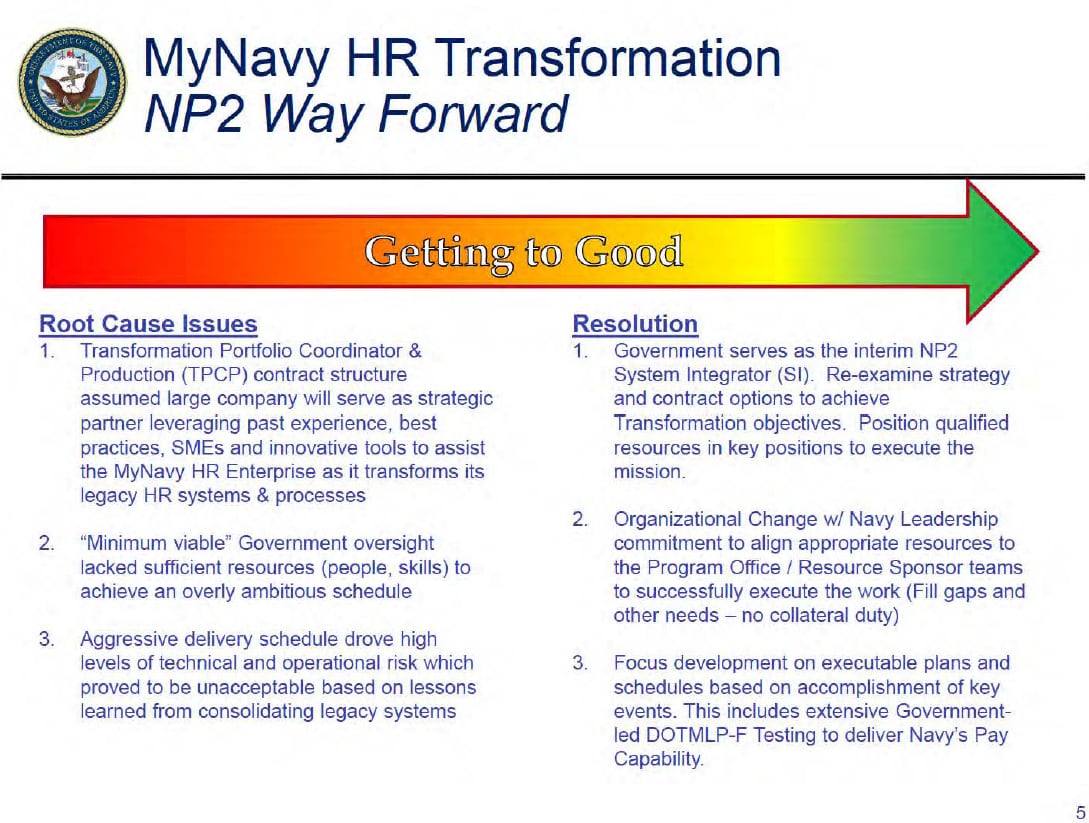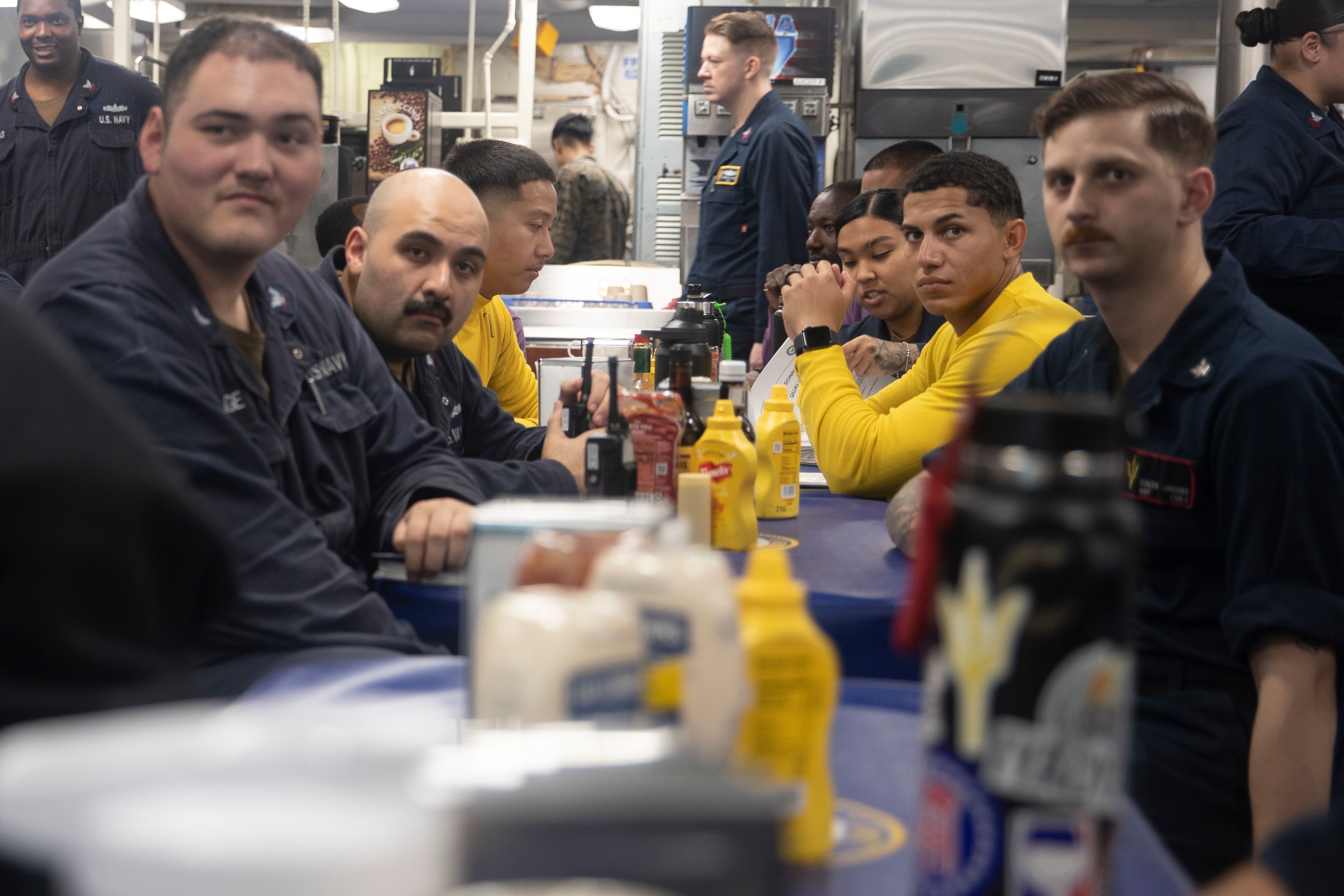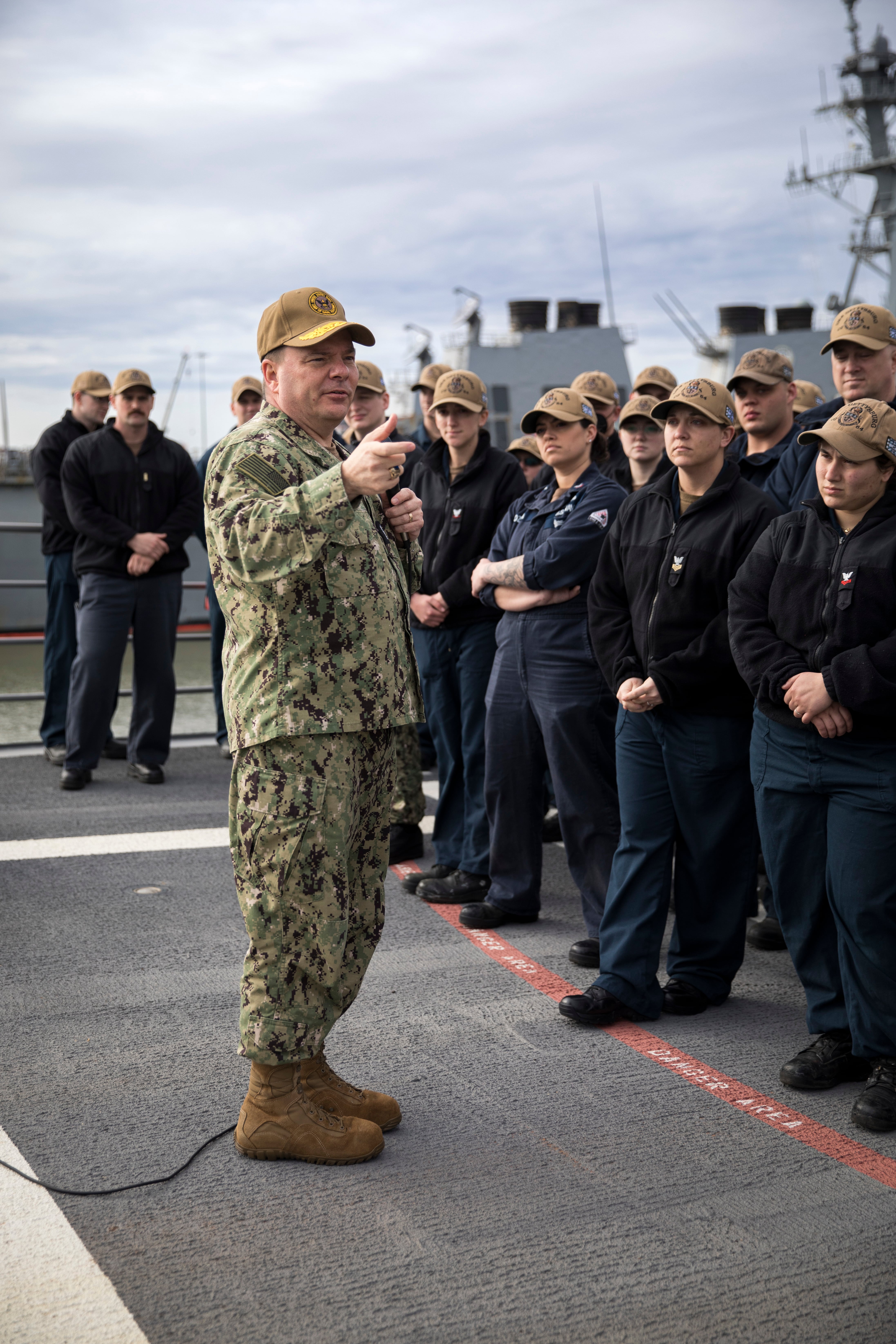In 2018, the three-star admiral in charge of Navy personnel promised the fleet would soon reap the benefits of a massive effort to modernize how the Navy handles pay, entitlements and retirements.
Collectively known as “HR Transformation” and formerly named “Sailor 2025,” the program would allow sailors to handle their pay and records needs from their phones, as easily as they bank, among other benefits.
As part of that process, the Navy would modernize and unify dozens of antiquated information technology systems that process pay and other sailor needs.
“By the end of 2019, Sailors will do most of their personnel business by smartphone ashore or desktop applications afloat,” then-Chief of Naval Personnel Vice Adm. Robert Burke wrote in “Proceedings” magazine. “By 2023, they will have forgotten about today’s personnel system and many of its frequent frustrations.”
But here in 2023, those grand promises have not materialized. In some ways, frustrations have only increased.
The Navy’s HR Transformation effort has disrupted pay, paperwork and benefits for thousands of sailors and veterans in recent years, according to a Navy Times investigation based on hundreds of pages of internal records and interviews with key leaders and sailors.

Some sailors have not been paid, while others have lost access to their healthcare or have not received the rent money or other entitlements that they are owed.
Most pressingly, those leaving active duty have seen their DD-214 and post-service paperwork and benefits severely delayed.
Eventually, the Navy has made these sailors whole, and Navy brass insist that the worst of these problems are in the service’s wake.
But they have yet to explain why the critical work of HR Transformation, slated to cost at least $1.6 billion, inflicted such pain on so many sailors.
Since the effort became an official program of record in 2019, much-heralded IT and HR systems have not come online as scheduled. Internal records reveal that the service has failed to monitor prime contractors, while not dedicating enough people with the technical know-how to do the meticulous and complex work of replacing legacy systems.
Meanwhile, the Navy shut down its old customer service model on the assumption that these new systems would come online on time, shuttering dozens of offices known as personnel support detachments, or PSDs, and shedding the personnel who worked in them. When the new systems didn’t arrive on time, a yawning customer service gap emerged.
The sea service has also at times stuck to “aggressive timelines” for rolling out key features that aligned with arbitrary dates on a calendar, records show, instead of timelines that reflected the extraordinary difficulty of the work involved, or what would happen if things went wrong.

This rush to meet deadlines played a part in nearly 3,000 sailors not getting paid or seeing their benefits interrupted in summer 2021 after a botched migration of the Navy’s enlisted and officer personnel systems, according to internal records and Navy officials.
To this day, the full extent of the problems caused by HR Transformation remain unclear, and Navy officials say they are not tracking all the disruptions caused by the modernization effort.
Still, the human toll of these missteps are apparent to those who suffered them.
Elizabeth Arms, 25, left the Navy in October. Along with thousands of her brethren in recent years, she did not have her DD-214 retirement paperwork in hand on her last day like departing servicemembers are supposed to, a problem both exposed and exacerbated by HR Transformation.
Because of the DD-214 processing backlog and Navy personnel systems showing she was still a sailor, Arms struggled to get listed as her sailor husband’s dependent while they were in Japan. This complicated efforts to get their young family back to the states early so their toddler could be treated for nonverbal autism, she told Navy Times.
RELATED

“The doctors we’ve spoken to have literally told us they’ve never seen this before,” Arms said of her family’s predicament, which resolved after Navy Times started asking questions.
Senior Chief Hospital Corpsman Chris Terry retired in November after 24 years of service, including stints in Iraq and Afghanistan.
He had to wait until March for Navy systems to catch up and pay him more than $12,000 in pay, benefits and vacation days he sold back.
His Veterans Affairs Department disability benefits also took months to kick in.
As a result, Terry said his family burned through their savings to make ends meet, and every office he contacted blamed another broken link in the bureaucratic chain.
“I love the Navy, it’s given me a career, a life, a family,” Terry said in January. “But the last six months have been the most stressful I’ve ever had to deal with in the Navy.”
A petty officer who requested anonymity for fear of reprisal said that dozens of sailors in his San Diego training school didn’t get their rent money for months last fall. Some resorted to driving Uber to make ends meet in the pricey city.
At a time when the military is struggling to recruit and retain people, the sailor said he has since questioned serving an institution that doesn’t seem to care.
“If the one item I’m guaranteed is not guaranteed, what am I doing this for?” he asked.
While officials did not provide a comprehensive tally of all incidents, other HR Transformation-related casualties have surfaced in recent years, and Navy Times has reported them out, often tipped off by sailors who felt they had nowhere else to turn.
In addition to the pay and benefits outage of 2021, HR Transformation has resulted in low-ranking sailors at the Navy’s nuclear training school in South Carolina not getting paid the housing money owed to them for months on end.
RELATED

The Navy’s new evaluation system, eNavFit, came online and was soon revealed as not quite ready for prime time.
When new IT systems planned as part of HR Transformation did not come online as planned, few backups existed to help sailors in need because of the PSD closures.
Michael Berman, a civilian IT expert who served as chief information officer for the California State University system, told Navy Times that organizations should avoid prematurely removing human redundancies when dealing with untested or unready technology.
“If you take humans out of the loop because you’re assuming the technology will work, that’s almost always a bad idea,” Berman said.
RELATED

Another aggravating factor was the fact that unit-level sailors in charge of helping their shipmates through thorny pay or records issues were woefully undertrained before reforms rolled out last summer.
Prior to the reforms, these command pay and personnel administrators—known as CPPAs—were given just two weeks of training. Some units had junior-ranking sailors navigating the Navy pay and personnel bureaucracy.
“This has not gone as planned,” Rear Adm. Stuart Satterwhite, the head of Navy HR, said last summer after the service announced the renewed effort to get after these problems.

‘Problems along the way’
The Navy’s HR Transformation was always going to be difficult.
Outside experts tell Navy Times that replacing or modernizing old IT systems can be challenging for any institution.
Oftentimes, institutions jerry-rig such systems over decades to keep them running, because they handle vital processes like pay that can’t be taken offline, even temporarily, according to Berman.
“You can look at places that have done these large transformations, and most of them have some problems along the way,” Berman said. “I have a lot of sympathy for folks trying to do to this kind of work…but I totally understand people who say, ‘we’re spending hundreds of millions of dollars, billions of dollars, and you don’t have anything to show for it.’”
The Navy’s HR Transformation effort involves replacing or modernizing 55 disparate, old IT systems.

In some cases, the legacy systems are running on engineering languages and code no longer in use, according to officials, and those who wrote the code are no longer around.
“We have been forced to conduct analysis to reverse engineer languages and coding to support our transformation efforts,” Capt. Jodie Cornell, a Navy spokeswoman, said in an email. “We have made great strides in doing this work, but we anticipate there will be additional complications as we work through the hundreds of interfaces and thousands of data exchanges.”
Cornell also said the Navy has been “forthright in the complexity” of HR Transformation.
“While we knew it would be complex at the time we started, we couldn’t know all the variables of the transformation until we actually began,” she said. “We made the best decisions we could, given the information we had at the time and our understanding of the risks associated with our awareness of the gaps in our information base.”
While Navy HR Transformation was always going to be a Herculean task, leaders have yet to precisely explain how these mistakes happened and whether sailor suffering could have been minimized.
After several Navy Times interviews with key leaders and hundreds of pages of records obtained via a Freedom of Information Act records request, what led to these failures—and whether anyone sounded the alarm in advance--remains unclear.
The Navy has yet to provide the full scope of records requested by Navy Times under FOIA.
The Chief of Naval Personnel, Vice Adm. Rick Cheeseman, told Navy Times earlier this year that a revised HR Transformation plan now underway should help prevent severe disruptions to pay, DD-214s and benefits going forward.

But outside IT experts warn that unforeseen problems do arise with such jobs, and Cheeseman did not rule out future “pockets of pain” for the fleet.
“We are laser focused on unburdening sailors and unburdening commands, so they can solely focus on the mission,” Cheeseman said. “I am really looking for 2023 to be sort of the year of transparency from us, getting out and telling our story.”
If anyone’s pay or benefits are interrupted, Cheeseman urged them to sound the alarm.
“For every step forward, we may take two steps back in a certain area,” he said. “I need sailors to be very vocal with their issues, let us know what’s going on….we’re working hard and we are laser-focused on making it better for them going forward.”
Retired Senior Chief Terry said he worries that junior sailors won’t speak up for fear of reprisal.
“If senior enlisted are facing these troubles, what are the junior enlisted facing, and what are the people facing that are afraid to say something?” Terry said this month.
While his team proceeds with lessons learned, Cheeseman indicated he is not interested in looking back at what went wrong.
“I put very little time into the autopsy,” he said.
The Navy can point to some victories.

Cheeseman has led an effort to require less so-called “key supporting documents” when processing things like leave, enlistment bonuses and housing entitlements. Stated simply, sailors have to show less forms when claiming certain benefits.
He also reported this month that the service’s DD-214 backlog “is gone,” and that a customer service center in Virginia is now months ahead, currently processing separation paperwork for sailors scheduled to leave this summer.
But even progress has revealed the complexity of the job.
Last fall, the Navy announced that it had cleared a backlog of thousands of sailors who left the service before Oct. 1 and were still awaiting their DD-214.
After Navy Times reported the development, sailors reached out to debunk that claim, alleging they had retired before that date and still didn’t have their paper.
Navy officials later confirmed a pocket of outstanding retirement packages were sitting in the system that nobody tracked because they were mislabeled or in the wrong queue.
“It should be criminal,” a senior officer, who retired last year and requested anonymity so that his job hunt wouldn’t be impacted, told Navy Times about retirement paperwork issues. “We’ve always been taught that you take care of sailors and they’ll take care of you. The Navy’s not taking care of people.”
‘Unacceptable’
As HR Transformation trundled along, the missteps have at times dragooned in lawmakers and outside entities.
Officials with the Navy-Marine Corps Relief Society say their non-profit has seen an increased need for financial aid for sailors in recent years due to pay and benefits disruptions.
“As the Navy began to transform its pay system, the Society saw increased requests for assistance due to challenges with pay and allowances,” society spokeswoman Gillian Gonzalez told Navy Times.
The society doled out roughly $2.9 million to 2,185 clients in 2017, according to Gonzalez.
That figure rose to $5.1 million for 3,566 members in 2019, and to $5.6 million for 2,991 to members with “pay problems” in 2022, she said.
Society officials are in regular contact with Navy HR about such issues, and Gonzalez said in January they are hopeful the problems are ebbing because fewer folks are coming back for repeat assistance.
Meanwhile, sailors have increasingly turned to lawmakers for help.
Congressional inquiries to the Navy regarding DD-214 issues soared from 206 in 2018 to 429 in 2022, according to Navy data.
“There seems to be a lack of urgency among Navy officials in both finding a solution to these delays and communicating these delays to sailors,” Sen. Marco Rubio wrote in a scathing letter to Navy Secretary Carlos Del Toro in October. “It is apparent the Navy has not considered the hardships that sailors experience given the Navy’s delays in processing their paperwork.”
A Rubio constituent who contacted the Florida Republican’s office shared a copy of the letter with Navy Times.
Rubio’s staff confirmed the letter’s authenticity but declined further comment.
That retired officer said he was forced to hold onto his active-duty ID card, potentially breaking the law, because it was the only way he could log into the system to check on the status of his paperwork.
“Failing to live up to the government’s end of the bargain on taking care of servicemembers also exacerbates the existing recruitment crisis the Navy and other branches are facing,” Rubio wrote. “This is unacceptable.”

Joint Force challenges
The Navy does not suffer such HR modernization travails alone.
A bottleneck in a similar Army effort led to thousands of soldiers not getting their discharge paperwork in January.
The Air Force paused the rollout of its new evaluation system in November after that system failed to add evals to airmen’s official records, among other flaws.
“As we have shared our lessons learned with our sister services, we have found they are facing similar challenges with similar delays,” Cornell said in an email. “And we are all reminded of the hard-learned lessons of the Department of Defense’s pursuit of the Defense Human Integrated Resources System.”
Known as DIMHRS, the Pentagon’s HR transformation effort burned through $1 billion over 12 years before officials pulled the plug in 2010.
Former Chairman of the Joint Chiefs of Staff Adm. Mike Mullen called the effort “a disaster,” while former Defense Secretary Robert Gates said the only thing the program produced was “an unpronounceable acronym.”
Decades spent patchworking aging IT systems to keep them running is common in many large institutions and is known as “technical debt,” according to Berman.
“If you never pay your credit cards off in full but you just pay the minimum payment every month, eventually you’re going to be in trouble,” Berman said. “It’s the same thing with an IT system.”
Navy officials say this work has to be done.
And while they’re reluctant to place any firm date on when sailors will handle their HR needs entirely on their phone, they promise that the pain will be worth it.
“We could no longer stand aside, doing nothing,” Cornell said. “That had been done for decades and the cost of maintaining an antiquated HR system that was not meeting the needs of our Sailors and their families was becoming prohibitively expensive and utterly unacceptable.”
More questions
The Navy has instituted a raft of reforms that leaders say will make transformation less painful going forward, but questions persist.
The service brought on a longtime government executive and IT specialist, Manuel Hermosilla, to lead the HR Transformation effort in late 2021.
Before that, an IT expert had not been leading the tech-heavy HR Transformation effort since it became a program of record in 2019.
While today’s HR Transformation leadership is focused on moving forward, records obtained by Navy Times suggest what went wrong.
PowerPoint slides point to “minimum” Navy oversight on prime contractors, while noting “aggressive delivery” schedules and “high levels of technical and operational risk” as prominent factors in the 2021 imbroglio that disrupted pay and benefits for thousands of sailors.

Cheeseman’s predecessor, now-retired Vice Adm. John Nowell, was in charge when that outage occurred, and he began a raft of HR Transformation reforms in May 2022, weeks before he handed the CNP reins to Cheeseman, records show.
In an internal memo, Nowell wrote that reforms require “a stable billet structure, a technically competent workforce, and sufficient resources,” raising questions about why such pillars weren’t in place before.
Now retired, Nowell did not respond to a request for comment sent to his LinkedIn profile or through the Naval War College, where he is an advisor.
“It is clear that, given the benefit of perfect hindsight, that no leader would intentionally direct a course that would lead to those results,” CNP Cheeseman’s spokeswoman, Cornell, said in an email.

‘We owe them the visibility’
Cheeseman insists that the difficult work of HR Transformation is going more smoothly, and disruptions are less frequent than they once were.
The DD-214 backlog is a thing of the past, and travel claims are getting processed faster, he said.
Even disruptions are helping improve the system, Cheeseman said.
Issues uncovered when junior sailors did not get paid their rent money for months while undergoing nuclear training in South Carolina led to overall process improvements, he said.
Some HR Transformation accomplishments, such as an online portal for sailors to file their permanent change of station, or PCS, claims are up and running, but Cheeseman noted that only about a quarter of the fleet are using that option.
The Navy has also in recent months started notifying commands in advance of transformation-related system outages, but why that wasn’t done from the start remains unclear.
“We are much more transparent with all system stakeholders on these upgrades,” Cheeseman said. “We owe them the visibility.”

But while claiming progress, Cheeseman was reluctant to say when a modernized system will be up and running.
“It would be empty and premature for me to say what date we’re actually going to be able to target,” he said. “We should know a little bit more in the spring to be able to tell leadership and Congress where we think we’re going to go.”
While Cheeseman is loath to tack on any firm dates for when HR Transformation will be completed, internal records show that the main system sailors will one day use on their phones, Navy Personnel and Pay, or NP2, likely won’t come fully online until January 2024 at the earliest, two years late.
The consolidation of the 55 legacy IT systems is not expected to be completed until fiscal year 2028.
‘Failure is not an option’
HR Transformation envisions a time when automated systems will help sailors through most of their pay and personnel needs, with a handful of “centers of excellence” serving as backstops for tougher issues.
These six centers are backed up by 13 regional support centers, Cornell said, replacing the network of 67 personnel support detachments, or PSDs, that once existed on bases to help sailors. Those PSDs were closed on the assumption that the new HR systems would come online as scheduled.
“Realignment of the work wasn’t completed until September 2022, therefore the efficiencies that come from consolidation have not yet been completely realized,” she said. “The important takeaway is that we are always adapting, learning and improving.”
Cheeseman said he hears the gripes of sailors who miss the old model.
“I totally understand they want to go sit next to somebody at PSD and talk about it,” Cheeseman said. “But for every negative story we get…we hear very positive comments through our (MyNavy Career Center) that their issue was resolved. Again, they got to an expert faster than they would have in the past. So we need to do a better job telling that story.”
But to some sailors, not having a physical office on their base to go to has so far made pay or DD-214 issues that much more vexing.
“There’s no customer service anymore,” a retiring chief who was issued a mistake-riddled copy of his DD-214, told Navy Times last year. “Everything’s through email. You can’t walk into a building and ask questions. You’re kind of screwed.”
“The Navy took away the personnel support detachments from commands and isolated it into a central point of failure with the (centers of excellence),” retired Senior Chief Terry said.
Officials also blame funding cuts by Congress and the COVID pandemic for HR Transformation lines of effort not coming online on time.

Cheeseman said the unexpected has hindered the Navy’s efforts, and outside experts say such surprises are common with IT modernization jobs.
“As we got down the transformation road, and as we started bolting on new systems…you’re quickly learning the lessons and it becomes a lot more complex,” he said. “Trying to turn those lessons fairly quickly in what was a COVID environment was problematic.”
Going forward, the Navy plans to more consistently update and modernize such systems, so that future sailors won’t grapple with the kind of cobwebbed, long-neglected arrays the Navy is now struggling to replace.
“If we fail to do this, we will find ourselves back in the situation of trying to operate this HR enterprise with inferior, out of date tools and solutions,” Cornell said. “That is why failure is not an option.”
Geoff is the managing editor of Military Times, but he still loves writing stories. He covered Iraq and Afghanistan extensively and was a reporter at the Chicago Tribune. He welcomes any and all kinds of tips at geoffz@militarytimes.com.




